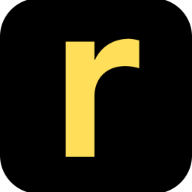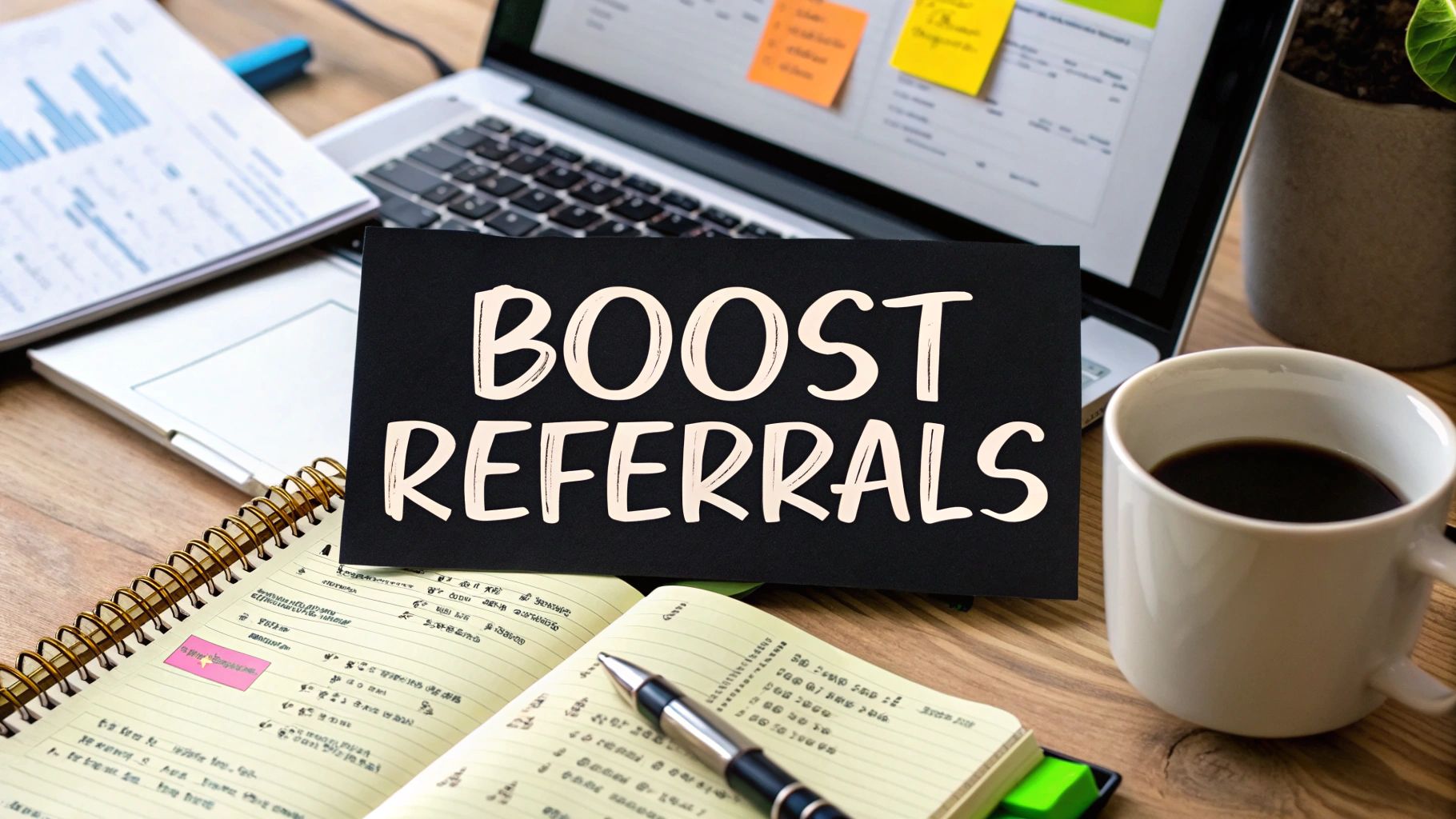Why Most Referral Programs Fail (And How Yours Won't)

Let's be honest, most referral programs just don't work. A whopping 87% never really get off the ground. I've seen it happen time and again, helping businesses navigate their referral strategies. The issue usually isn't the how, it's the why—a basic misunderstanding of what truly motivates people to share. Too many businesses treat referrals like transactions, forgetting the human element: relationships.
Think about your own experiences. When was the last time you raved about something just because a company dangled a discount? Probably never. We share things that genuinely add value to our lives, things we want others to benefit from. That's the golden ticket to a successful referral program: genuine enthusiasm.
This means shifting the focus from transactional rewards to building a real community around your product. For a good overview of referrals, check out Fame's page on the topic. Building a referral program that taps into this organic desire to share starts with identifying your ideal referral moment. You want to be a helpful friend, not that annoying person constantly pushing products.
Understanding Referral Rates and Motivations
Understanding the average referral rate is also important. Globally, it hovers around 2.35%. This means for every 100 customers, only a couple will refer someone else. To bump those numbers up, companies often use referral incentives and streamline the referral process. For more on referral rates, head over to ReferralCandy's blog. Figuring out what makes your audience tick is key.
Another critical piece of the puzzle is the overall customer experience. If your product isn't delivering, no incentive will convince your customers to recommend it. A smooth user experience, excellent customer support, and a product that truly solves a problem—these are the cornerstones of any successful referral program. For some best practices, take a look at Refgrow's blog post.
A well-designed program, paired with a great product and targeted outreach, is the formula for sustainable growth. Building a thriving referral program isn't about tricks; it's about fostering genuine advocacy.
Mapping The Perfect Referral Moment
Timing is everything with referral programs. So many businesses completely miss the boat. They ask for referrals at random, or even worse, right after someone buys something – before the customer has even had a chance to use it!
I've looked at tons of successful referral interactions, and there's a definite pattern: There are sweet spots when customers are just naturally more likely to share. It’s all about understanding the customer journey and finding those “golden” referral opportunities—times when they’re happy and sharing feels natural, not forced. Think of it like baking a cake; you wouldn’t ask for a taste test before it’s done!
Identifying Emotional Triggers
Figuring out what emotionally triggers a referral is key. What makes someone want to tell their friends? It’s rarely just about a discount. It’s about feeling valued, having a great experience, and wanting others to have that too. This means designing touchpoints that tap into that natural enthusiasm. Think about how you recommend things to friends. You don't just say, “Here’s a link, get a discount.” You share your experience.
For example, take a SaaS product for managing social media. The ideal time to ask for a referral probably isn’t right after signup. It’s more likely when the user sees real results—more engagement, a bump in followers, or maybe even landing their first social media-driven sale. That’s when they’re excited and ready to share.
Crafting the Perfect Ask
Another important piece is making referral requests feel like opportunities, not obligations. No one wants to feel pressured. Framing the referral as a way to help friends discover something useful is way more effective than a generic ask.
I've seen referral rates double just by changing when the ask happens. Think about it: asking after a customer solved a big problem with your product is much more powerful than asking right after they sign up. You want to craft messaging that makes customers proud to recommend you. Maybe you highlight the benefits their friends will get or showcase the impact their referral will have.
Making sharing super easy is essential, too. People should actually enjoy using your referral system. Refgrow, for instance, lets you build a referral program that's baked right into your SaaS product, making sharing a breeze. The secret to getting natural recommendations instead of forced referrals is understanding these key moments, using the right message, and making sharing frictionless.
Building Your Referral Engine Without Breaking The Bank
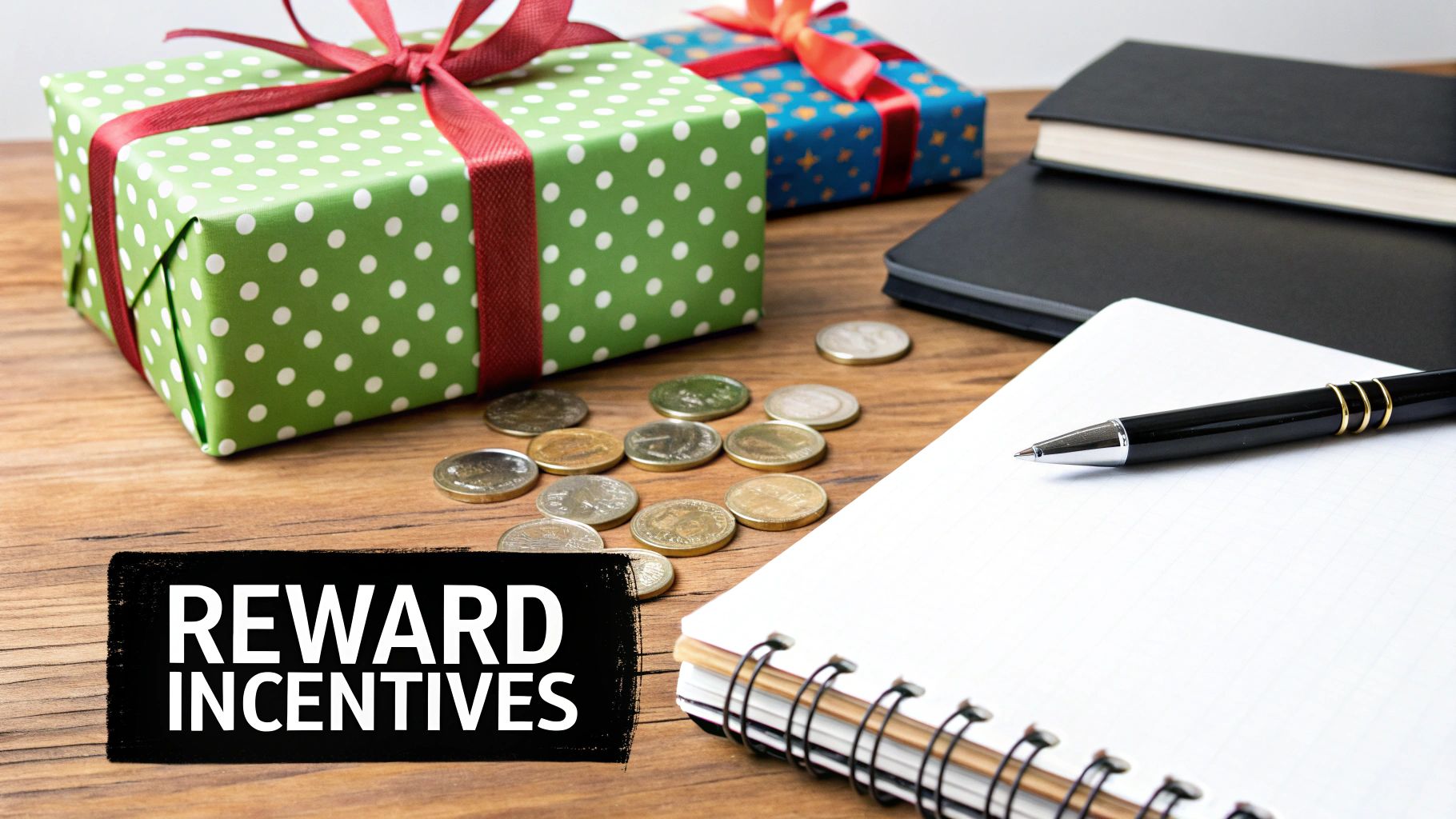
Let's talk referral programs. You don't need some crazy complex system, but it has to be dependable. I've seen so many promising programs fall apart because the tracking was buggy or the user experience was just awful. Let’s skip the fluff and focus on what matters: building a program that actually works.
Essential Components of a Referral Program
Forget the fancy stuff you see in sales pitches. Here’s the core of what you need:
Rock-Solid Tracking: Seriously, this is non-negotiable. Accurate tracking across all devices is a must. If referrals aren’t tracked correctly, you’ll end up frustrating your advocates and losing key data.
Seamless Reward Fulfillment: Don't turn rewards into a customer service nightmare. Automate this as much as you can. It simplifies things for everyone.
Intuitive Interfaces: Make it ridiculously easy for people to understand how to refer and share their links. Confusing interfaces absolutely kill conversion rates.
Choosing the right platform really depends on your business. For SaaS companies, embedding the referral program directly within your app creates a truly smooth experience. This is where something like Refgrow is a game-changer. You can launch a fully customizable referral dashboard right inside your product with just a single line of code.
Before I move on, let's talk about some of the key players in the referral program space. Choosing the right tool for your needs is crucial, so here's a quick comparison:
Referral Program Platform Comparison
| Platform | Best For | Key Features | Starting Price | Integration Options |
|---|---|---|---|---|
| Refgrow | SaaS businesses | In-app dashboards, automated rewards, powerful analytics | Varies | Stripe, LemonSqueezy, and more |
| Friendbuy | E-commerce businesses | Customizable widgets, multi-channel sharing, fraud prevention | Varies | Shopify, Magento, and more |
| Talkable | Enterprise businesses | Advanced segmentation, A/B testing, dedicated support | Varies | Salesforce, Marketo, and more |
| ReferralCandy | Small to medium businesses | Simple setup, email marketing integration, referral tracking | Varies | Shopify, WooCommerce, and more |
This table gives you a starting point for your research. Look at the key features and integrations to see which platform best fits your current setup and goals.
Integrating With Your Existing Tools
Integration shouldn't make your life harder. Refgrow, for instance, works seamlessly with tools like Stripe and LemonSqueezy, automating payouts and streamlining the admin side of things. This keeps your financial processes neat and tidy. Remember, the goal is to improve your existing systems, not complicate them.
Testing Before Launch
Before you launch anything, test it thoroughly. I mean really test it. Think real-world scenarios, different devices, and all the weird edge cases you can imagine. Thorough testing helps you catch bugs before they affect your users. Trust me, a bit of preventative work now saves major headaches later.
Building a solid referral program comes down to picking tools that work reliably and creating a fantastic experience for everyone involved. It's not about the fanciest features, it's about a system you can rely on. And remember, things will go wrong sometimes. Have backup plans. Be ready to adapt. The businesses that see huge referral growth are the ones who build systems that work consistently and create a great experience for both referrers and new customers.
Designing Rewards That Motivate Without Bankrupting You
This is where it all comes together: your reward structure. A good reward system can supercharge your referral program. A bad one? Let's just say it can drain your budget fast. I've played around with a ton of incentive models, and here's the biggest takeaway: bigger isn't always better. The best programs figure out what customers really want, and sometimes that's not just cash.
Calculating Sustainable Reward Levels
Finding that balance between motivating referrals and keeping your profits healthy is key. A classic mistake is offering massive discounts that end up eating your revenue. Instead, figure out your customer lifetime value (CLTV). This tells you how much you can realistically spend to get new customers through referrals.
Let's say your CLTV is $500. Giving a $50 reward to both the referrer and their friend might seem okay at first glance. But once you add in product costs, marketing, and other expenses, you'll see how those discounts can impact your bottom line. A smarter approach? Tiered rewards. Increase the incentive for people who refer multiple times. Maybe start with a $20 reward for the first referral, then $30 for the second, and so on. This keeps people engaged without overspending.
Exploring Non-Monetary Incentives
Want a secret weapon? Non-monetary rewards. These can sometimes be even more effective than cash. Think about it: your most loyal customers are often driven by things like exclusive access, early product previews, or even a shout-out on social media. These rewards build community and make your advocates feel like VIPs. Check out some more Referral Program Ideas for inspiration. This builds real relationships and turns customers into true fans. Also, when you're setting up your referral system, see if an Affiliate Program could help bring in even more referrals.
Preventing Fraud and Maintaining a Frictionless Experience
Rewarding customers is important, but so is protecting your program from fraud. Clear terms and conditions, fraud detection tools, and manually checking for anything fishy can help prevent abuse. Referral programs aren't just good for getting new customers – they're great for saving money too. Deloitte found that these programs can cut customer acquisition costs by 24% because referred customers are more loyal and have a higher lifetime value. For more interesting stats on referral programs, click here. Finding the right balance here is essential for long-term success.
Remember, your best customers often care more about being recognized and feeling like part of something special than they do about a small discount. Focus on building relationships and offering rewards that truly connect with your audience. This is how you create a referral program that delivers real growth without blowing your budget.
Launching Your Program For Maximum Impact
A killer referral program hidden away on your website is like a buried treasure—no one's ever going to find it! The launch is everything. It’s the make-or-break moment that determines whether your program soars or sinks. Having worked with companies across tons of industries, I've seen firsthand the good, the bad, and the ugly. So, let's dive into how to launch your program with a bang and, just as importantly, keep that momentum going.
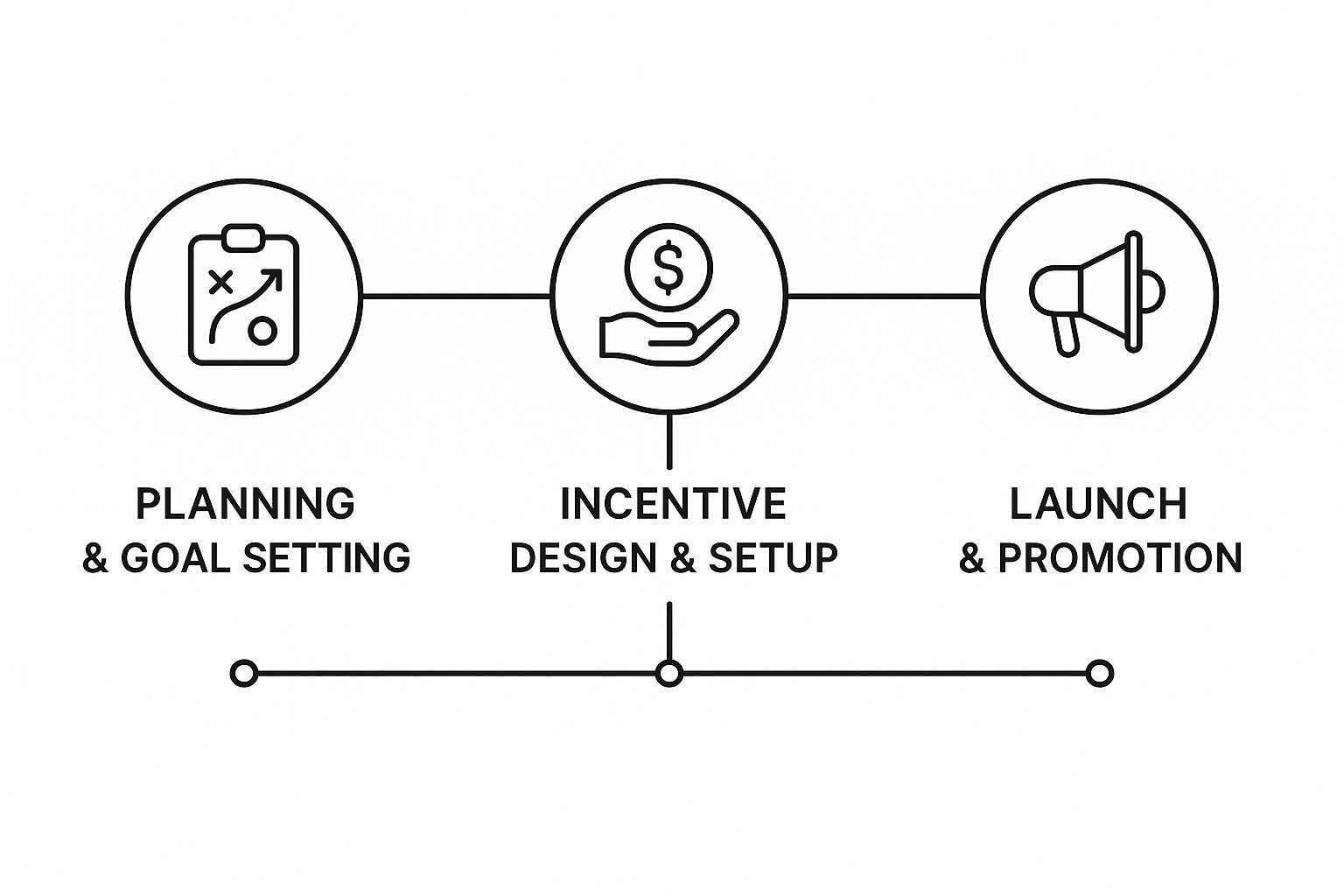
This infographic breaks down the three major phases of a referral program: Planning & Goal Setting, Incentive Design & Setup, and Launch & Promotion. See how they build on each other? A successful program isn't just about the launch; it's about laying the groundwork.
Proven Launch Strategies
Think of your launch like a Hollywood premiere—build anticipation! Start with a soft launch for your most loyal customers. These are your VIPs. Get their feedback, smooth out any wrinkles, and let them be your first wave of advocates. This early feedback is gold—use it to polish your program before the big reveal.
Then, go big! Launch a full-scale campaign that generates real buzz. Think creative, shareable marketing materials—not those generic, snooze-fest templates. Knowing your audience is key. Where do they hang out online? What kind of content grabs their attention?
Crafting the Right Message
Your launch message needs to be clear, concise, and all about the benefits. Don’t just announce the program; tell people why they should care! What's in it for them? How will referring friends make their lives easier or better? Maybe it's exclusive rewards, early access to new features, or simply the joy of sharing something they love.
For example, instead of a boring "Join our referral program," try something like, "Give your friends the gift of [your product benefit] and score rewards for yourself!" See the difference?
Maintaining Momentum Long After Launch
A strong launch is great, but it's just the beginning. You need a system for sustainable growth. Train your team to talk about referrals naturally. Make it part of their everyday customer conversations. Create engaging content that showcases the program's value. Think case studies, testimonials, or even social media contests.
Track your early performance and be ready to tweak your strategy. Launching a referral program is a marathon, not a sprint. The best programs are the ones that evolve and adapt over time, based on customer feedback and market trends. Keep promoting your program and keep it top-of-mind for your customers.
To help you visualize this whole process, I've put together a handy timeline. It covers the first 90 days of your referral program, highlighting key milestones, promotional activities, potential pitfalls, and the metrics you should be watching.
Referral Program Launch Timeline A comprehensive timeline showing key milestones, promotional activities, and success metrics for the first 90 days of your referral program
| Week | Focus Area | Key Activities | Success Metrics | Common Pitfalls |
|---|---|---|---|---|
| 1-4 | Soft Launch & Feedback | Recruit beta testers, gather feedback, refine program | Referral conversion rate, average referral value | Not enough testers, ignoring feedback |
| 5-8 | Full-Scale Launch | Marketing campaign across multiple channels, social media push | Number of referrals, new customer acquisition cost | Weak messaging, ineffective targeting |
| 9-12 | Optimization & Refinement | Analyze data, adjust incentives, A/B test messaging | Referral program ROI, customer lifetime value | Not tracking metrics, failing to adapt |
| 13-24 | Community Building | Create exclusive content for referrers, run contests | Referral program engagement, customer satisfaction | Lack of communication, generic content |
| 25-90 | Scaling & Automation | Automate referral process, explore new partnerships | Referral program growth, revenue generated | Over-automation, neglecting personal touch |
This timeline is a starting point, of course. You'll want to customize it to fit your specific business and goals. But it gives you a framework to follow and helps you stay on track during those critical first few months. Remember, consistency is key! Keep nurturing your referral program, and it will become a powerful engine for growth.
Tracking What Matters And Optimizing For Growth
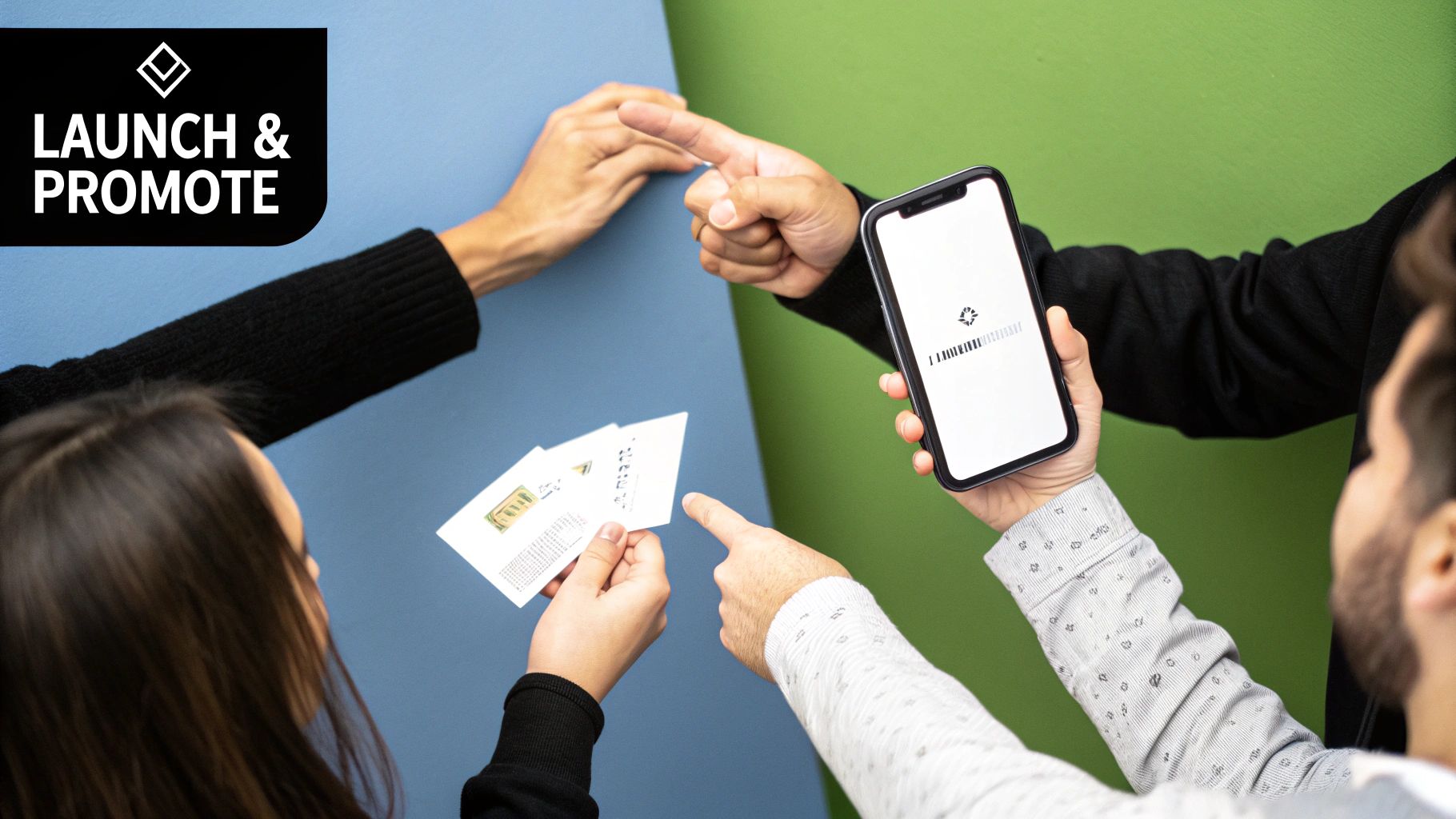
So many referral programs launch with a bang and then… crickets. They just sort of fade into the background. But the companies truly crushing it with referral marketing treat their programs like the powerful engines they are, constantly tuning and improving them. It's not about just counting referrals; it's about understanding what those numbers really mean.
Metrics Beyond Referrals
Let’s be honest, raw referral numbers don’t tell the whole story. Are those referrals actually turning into valuable customers? What's the actual ROI of your program? Catching bottlenecks in your referral funnel before they become major headaches is crucial. It’s a bit like a small leak in your roof – ignore it now, and you’ll be dealing with a much bigger (and more expensive) problem later.
For example, you might see a ton of clicks on your referral links, but very few conversions. This could signal a few things: maybe your landing page needs some love, your offer isn’t enticing enough, or you’re targeting the wrong audience. Figuring out these weak points lets you laser-focus your efforts where they’ll make the biggest difference. Need some more tracking tips? Check out Refgrow's guide.
Optimizing and Re-engaging
A/B testing is your best friend here. Play around with different rewards, messaging, and sharing options. Find out what actually clicks with your audience. It's all about experimenting and iterating. And don’t forget about the people already singing your praises! Keep your existing advocates engaged with personalized emails, exclusive offers, or sneak peeks at new features. Make them feel valued – because they are!
Honestly, even tiny changes can have a huge impact. I’ve personally seen referral rates double and even triple just by tweaking things like the call to action or the subject line of a referral email. It's a constant process of experimenting and learning what works best for your specific audience. On that note, employee referral programs are exploding right now, especially in industries struggling to find talent. In fact, 88% of tech companies rely on referrals as a primary hiring source. Why? Referred employees tend to perform better and stick around longer. Check out these eye-opening stats. It really highlights the power of referrals across the board.
Maintaining Momentum and Scaling for Growth
Keeping an eye out for early warning signs, like dipping referral rates or low engagement, is essential. Regular maintenance – like reviewing your rewards, refreshing your marketing materials, and keeping your tracking system current – can keep your program humming along. Think of it like a well-oiled machine: a healthy referral program needs consistent care to run smoothly. It’s an investment, not a set-it-and-forget-it project. Building a systematic approach to continuous improvement is the name of the game. You're not looking for one-time wins; you’re building momentum for long-term, compounding growth.
Your 90-Day Referral Program Action Plan
Let's get down to brass tacks and map out a practical 90-day plan for your referral program. Think of this as your personal guide for the next three months, complete with realistic timelines, key decisions, and a heads-up on potential bumps in the road. We'll cover how to prioritize based on your resources, create systems to keep you on track, and set benchmarks so you can see how you're doing every step of the way.
When you're fine-tuning your referral program's landing pages, you'll want to make sure they're easy to find. Check out this article on optimizing your site for a wide range of search queries. It's packed with helpful strategies to boost your visibility.
Phase 1: Planning and Setup (Month 1)
First things first: lay the groundwork for a referral program that truly aligns with your specific business. I recommend starting with a deep dive into your customer journey. Where are those key moments where a customer might be most likely to refer a friend?
Think about what really motivates your customers. Don't just assume it's cash – sometimes things like exclusive access or early product previews are much more enticing. Finally, get your tech stack in order. A tool like Refgrow lets you embed a referral program directly within your SaaS product, which can be a real game-changer.
Phase 2: Launch and Initial Traction (Month 2)
This is where things get exciting! Don't just quietly release your program – build some buzz! I like to start with a soft launch to a small group of loyal users. This gives you a chance to get valuable feedback and smooth out any wrinkles before going wide.
Then, it's time for the main event! Roll out your full launch campaign across all your channels: email, social media, even partnerships. Remember to keep the momentum going with fresh content and consistent promotion to keep your audience engaged.
This screenshot from ReferralCandy is a great example of a clean, easy-to-understand referral program interface. See how it clearly highlights the benefits for both the referrer and their friend? Clear communication is crucial for driving participation.
Phase 3: Optimization and Scaling (Month 3)
Launching your program is just the beginning. Now comes the fun part: optimizing and scaling. This is where the real magic happens! Dive into your data, track your key metrics, and figure out what’s working and what’s not.
A/B test everything – from your messaging to your rewards structure. Keep your advocates happy with exclusive perks and personalized communication. As your program grows, streamline your automation and look for opportunities to scale.
Building a thriving referral program is an ongoing journey. With a solid plan and consistent effort, you can turn your customers into your most powerful growth engine. Ready to build a truly native referral program in a snap? Give Refgrow a try and start seeing results today.
